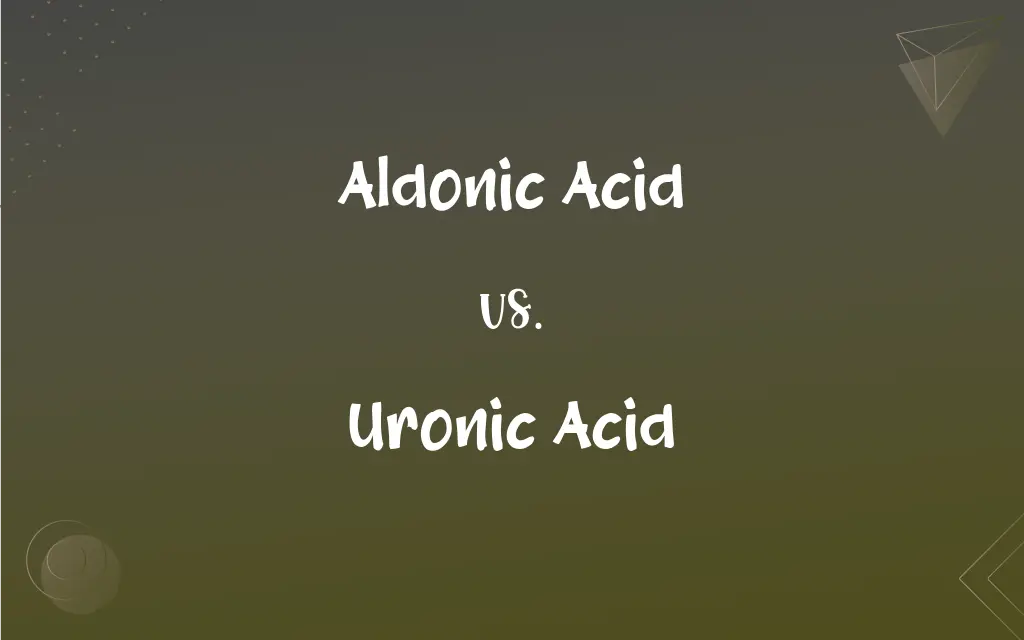Aldonic Acid vs. Uronic Acid: What's the Difference?
Edited by Aimie Carlson || By Janet White || Published on March 1, 2024
Aldonic acids result from the oxidation of the aldehyde group in aldoses to a carboxylic acid; uronic acids are formed by oxidizing the terminal CH2OH group of sugars to a carboxylic acid.

Key Differences
Aldonic acids are produced through the oxidation of the aldehyde functional group present in aldose sugars to a carboxylic acid. This reaction does not alter the position of the hydroxyl groups along the carbon chain, maintaining the sugar's original stereochemistry. Uronic acids, on the other hand, are formed by the oxidation of the primary alcohol group (CH2OH) at the terminal carbon of monosaccharides to a carboxylic acid, effectively converting the last carbon of the sugar into a carboxylic acid group.
The significance of aldonic acids in biological systems and industry lies in their role as intermediates in the oxidation pathways of sugars, as well as in their use in chelating agents and in the synthesis of biodegradable polymers. Uronic acids are crucial components of polysaccharides such as pectin and glycosaminoglycans, playing essential roles in cellular communication, the structural integrity of extracellular matrices, and the detoxification of substances in the liver.
Structurally, aldonic acids retain the same carbon count as their parent aldoses, with the conversion of the aldehyde group to a carboxyl group occurring at the first carbon. This structural change imparts new properties to the molecule, such as increased solubility in water and the ability to form stable complexes with metal ions. Uronic acids also exhibit increased solubility and the ability to interact with proteins and metal ions, but the oxidation at the terminal carbon also impacts the sugar's conformation and its participation in the formation of long-chain polymers.
In terms of synthesis and applications, aldonic acids can be obtained both through chemical oxidation and enzymatic processes, and they are used in food, pharmaceuticals, and as building blocks in chemical synthesis. Uronic acids are similarly versatile, with applications ranging from the production of pharmaceuticals to their use as gelling agents in food and as key components in cosmetic products.
Comparison Chart
Site of Oxidation
Aldehyde group at C-1
Primary alcohol group at the terminal carbon
ADVERTISEMENT
Resulting Functional Group
Conversion to carboxylic acid at C-1
Conversion to carboxylic acid at the terminal carbon
Carbon Count
Unchanged from parent aldose
Unchanged, but functional group shift
Biological Role
Intermediates in oxidation pathways, chelating agents
Components of structural polysaccharides, detoxification
Applications
Food, pharmaceuticals, biodegradable polymers
Pharmaceuticals, food gelling agents, cosmetics
Aldonic Acid and Uronic Acid Definitions
Aldonic Acid
Results from aldehyde group oxidation in sugars.
The oxidation of glucose produces gluconic acid, a type of aldonic acid.
ADVERTISEMENT
Uronic Acid
Forms from primary alcohol group oxidation in sugars.
The presence of uronic acid in pectin contributes to its gelling properties.
Aldonic Acid
Oxidized aldose sugars with a carboxylic acid at C-1.
Gluconic acid, an aldonic acid, is widely used in food and pharmaceuticals.
Uronic Acid
Used in cosmetics and pharmaceuticals for its unique properties.
Uronic acid derivatives are common in cosmetic formulations for skin health.
Aldonic Acid
Forms stable complexes with metal ions.
Calcium gluconate, derived from aldonic acid, is used in calcium supplements.
Uronic Acid
Oxidized monosaccharides with a carboxylic acid at the terminal carbon.
Glucuronic acid, a uronic acid, plays a crucial role in detoxifying drugs in the liver.
Aldonic Acid
Soluble in water, used in chelation therapy.
Aldonic acid's ability to chelate metals makes it valuable in detoxifying treatments.
Uronic Acid
Enhances solubility and protein interaction.
Uronic acids in glycosaminoglycans facilitate cellular communication.
Aldonic Acid
Maintains sugar's carbon count with aldehyde to acid conversion.
Aldonic acids are essential for synthesizing environmentally friendly polymers.
Uronic Acid
Integral to structural polysaccharides and extracellular matrices.
Hyaluronic acid, containing glucuronic acid units, is vital for skin hydration.
FAQs
Can aldonic acids form polymers?
Yes, they're used in synthesizing biodegradable polymers.
What role do uronic acids play in the body?
They're key in forming structural components of cells and in the detoxification process.
What makes aldonic acid different from uronic acid?
Aldonic acid is derived from the oxidation of an aldose's aldehyde group, whereas uronic acid results from oxidizing the terminal primary alcohol group of sugars.
How do aldonic acids interact with metal ions?
They form stable chelates, useful in nutrition and detoxification.
How are uronic acids utilized in the pharmaceutical industry?
As active components in drugs and for their detoxifying properties.
What is a common source of aldonic acids?
Glucose oxidation produces gluconic acid, a well-known aldonic acid.
What is the significance of aldonic acid in environmental science?
They're used in creating eco-friendly materials and in soil remediation.
Where are aldonic acids commonly found?
In oxidation pathways of sugars and in various industrial applications.
What makes uronic acids essential in food technology?
Their gelling properties, derived from pectin content, are crucial for food textures.
Can uronic acids be synthesized?
Yes, through chemical or enzymatic oxidation of monosaccharides.
How do uronic acids affect the extracellular matrix?
They provide structural integrity and resilience by forming part of polysaccharides like hyaluronic acid.
What is the role of uronic acids in plant growth?
They are components of plant cell walls, contributing to growth and stability.
Why are uronic acids important in cosmetics?
They contribute to hydration and skin health properties in cosmetic products.
Are aldonic acids safe for consumption?
Yes, when used appropriately, such as in food additives and pharmaceuticals.
What distinguishes aldonic acids in chelation therapy?
Their specificity and efficiency in binding metal ions for removal from the body.
Are aldonic acids naturally occurring?
Yes, they occur naturally in oxidation reactions of sugars.
How do uronic acids contribute to cellular communication?
Through their incorporation in glycosaminoglycans, facilitating cell-cell interaction.
What is the impact of uronic acids on drug metabolism?
Glucuronic acid conjugation is a major pathway for drug detoxification in the liver.
Can aldonic acids be used in all types of food products?
They're suitable for many, but usage depends on the specific regulatory approvals and desired properties.
How do aldonic acids and uronic acids differ in water solubility?
Both increase water solubility compared to their parent compounds, enhancing their biological and industrial utility.
About Author
Written by
Janet WhiteJanet White has been an esteemed writer and blogger for Difference Wiki. Holding a Master's degree in Science and Medical Journalism from the prestigious Boston University, she has consistently demonstrated her expertise and passion for her field. When she's not immersed in her work, Janet relishes her time exercising, delving into a good book, and cherishing moments with friends and family.
Edited by
Aimie CarlsonAimie Carlson, holding a master's degree in English literature, is a fervent English language enthusiast. She lends her writing talents to Difference Wiki, a prominent website that specializes in comparisons, offering readers insightful analyses that both captivate and inform.
































































